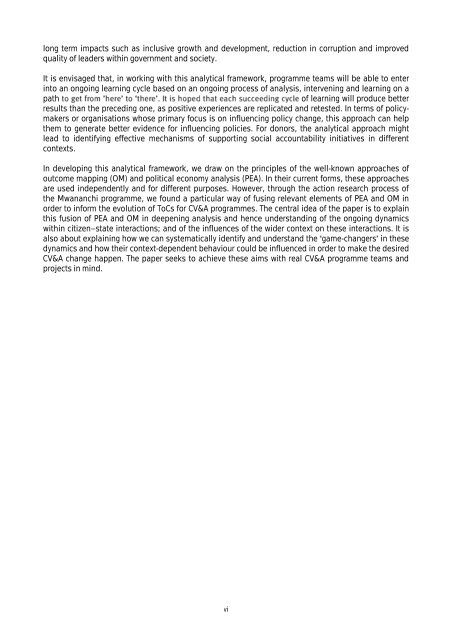Executive summaryOur bargain with taxpayers is this: in return for contributing your hardpoorestpeople, it is our duty to spend every penny of aid effectively. My top priority will be to securemaximum value for money in aid through greater transparency, rigorous independent evaluation <strong>and</strong> anunremitting focus on results Andrew Mitchell, UK Secretary of State for International Development, Speechdelivered on 12 May 2010.Development practice is increasingly being pushed to achieve results as well as to explainsuch results.Therefore, while putting an unremitting focus on results , as Andrew Mitchell says, developmentpractitioners are now also investing increasingly in underst<strong>and</strong>ing the factors that shape results,positive or otherwise. The shift to this way of working could be explained partly as being a result of aneed to achieve more efficiency in the use of increasingly scarce aid resources, especially in thecontext of the global financial crisis. It might also reflect concerns of the general impasse around aid<strong>and</strong> its results among development professionals themselves. There is particular concern regarding theways individual cases of success can be scaled up to other contexts so that broad-based nationaleconomic growth <strong>and</strong> development or poverty reduction objectives can be achieved.Making theories of change (ToCs) explicit right from the start of development projects 1 can help indiscovering what will need to hshort, medium <strong>and</strong> long term. Exploring ToCs should also become a central part of rigorousindependent evaluations <strong>and</strong> of ascertaining the effectiveness <strong>and</strong> impacts of developmentinterventions. In other words, good ToCs will enhance the rigour of evaluations from the beginning of anintervention process <strong>and</strong> not just at the end of a development programme.However, when current approaches to articulating <strong>and</strong> representing ToCs are applied to citizen <strong>voice</strong><strong>and</strong> <strong>accountability</strong> (CV&A) programmes <strong>and</strong> projects, programme managers find that realities are morecomplex <strong>and</strong> dynamic than can be captured with the tools they have at h<strong>and</strong>. This is because theserealities comprise ongoing <strong>state</strong> citizen relations involving a wide range of different actors who pursuetheir aims according to different interests <strong>and</strong> incentives. These relations are, in themselves, a complexweb of formal <strong>and</strong> informal interactions that are difficult to disentangle <strong>and</strong> explain. This complexityincreases even further when the multiple external relations, interests <strong>and</strong> influences in the specific<strong>state</strong> citizen relations targeted in CV&A projects are taken into account. All these internal <strong>and</strong> externalrelations mean that CV&A project interventions produce <strong>and</strong> reproduce diverse outcomes which are notamenable to the linear models of ToCs.In this paper, we provide a critical analysis of a series of CV&A cases from the Mwananchi Governance<strong>and</strong> Transparency Fund (GTF) programme 2 in order to develop some patterns of observation <strong>and</strong>thought lines which, when put together, form an analytical framework for developing ToCs for CV&Aprojects. The analytical framework focuses attention on how to explore, underst<strong>and</strong> <strong>and</strong> explain changeas it occurs in a dynamic context, <strong>and</strong> then how this can help in the formation of more realistic CV&Aobjectives <strong>and</strong> the resultant outcomes. It provides CV&A programme teams with a way of navigatingvarious context-dependent dynamics of citizen-<strong>state</strong> engagement in order to achieve intermediateoutcomes such as changes in policies <strong>and</strong> practice (e.g. increased access to better public services forpoor citizens). Most programme teams also aim to have these intermediate outcomes contribute to1ialchange objective, is time-bound <strong>and</strong> is resourced in a particular way to achieve the intended aims. We deliberately use thewords programme <strong>and</strong> project interchangeably in this paper.2The GTF is a one-off funding mechanism created by the UK Department for International Development as part of itspolitical governance in working with media, civil society organisations (CSOs), trade unions etc.v
long term impacts such as inclusive growth <strong>and</strong> development, reduction in corruption <strong>and</strong> improvedquality of leaders within government <strong>and</strong> society.It is envisaged that, in working with this analytical framework, programme teams will be able to enterinto an ongoing learning cycle based on an ongoing process of analysis, intervening <strong>and</strong> learning on apathof learning will produce betterresults than the preceding one, as positive experiences are replicated <strong>and</strong> retested. In terms of policymakersor organisations whose primary focus is on influencing policy change, this approach can helpthem to generate better evidence for influencing policies. For donors, the analytical approach mightlead to identifying effective mechanisms of supporting social <strong>accountability</strong> initiatives in differentcontexts.In developing this analytical framework, we draw on the principles of the well-known approaches ofoutcome mapping (OM) <strong>and</strong> political economy analysis (PEA). In their current forms, these approachesare used independently <strong>and</strong> for different purposes. However, through the action research process ofthe Mwananchi programme, we found a particular way of fusing relevant elements of PEA <strong>and</strong> OM inorder to inform the evolution of ToCs for CV&A programmes. The central idea of the paper is to explainthis fusion of PEA <strong>and</strong> OM in deepening analysis <strong>and</strong> hence underst<strong>and</strong>ing of the ongoing dynamicswithin citizen <strong>state</strong> interactions; <strong>and</strong> of the influences of the wider context on these interactions. It isalso about explaining how we can systematically identify <strong>and</strong> underst<strong>and</strong> the game-changers in thesedynamics <strong>and</strong> how their context-dependent behaviour could be influenced in order to make the desiredCV&A change happen. The paper seeks to achieve these aims with real CV&A programme teams <strong>and</strong>projects in mind.vi
















